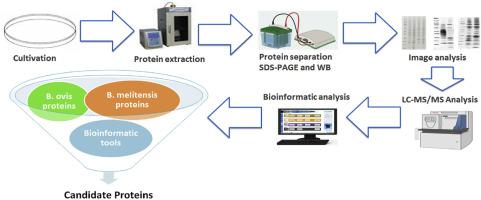当前位置:
X-MOL 学术
›
Mol. Cell. Probes
›
论文详情
Our official English website, www.x-mol.net, welcomes your feedback! (Note: you will need to create a separate account there.)
Proteomic analysis of Brucella melitensis and Brucella ovis for identification of virulence factor using bioinformatics approachs.
Molecular and Cellular Probes ( IF 3.3 ) Pub Date : 2020-05-16 , DOI: 10.1016/j.mcp.2020.101581 Valentina Paci 1 , Ivanka Krasteva 2 , Massimiliano Orsini 2 , Tiziana Di Febo 2 , Mirella Luciani 2 , Fabrizia Perletta 2 , Adriano Di Pasquale 2 , Mauro Mattioli 3 , Manuela Tittarelli 2
Molecular and Cellular Probes ( IF 3.3 ) Pub Date : 2020-05-16 , DOI: 10.1016/j.mcp.2020.101581 Valentina Paci 1 , Ivanka Krasteva 2 , Massimiliano Orsini 2 , Tiziana Di Febo 2 , Mirella Luciani 2 , Fabrizia Perletta 2 , Adriano Di Pasquale 2 , Mauro Mattioli 3 , Manuela Tittarelli 2
Affiliation

|
The genus Brucella includes several genetically monomorphic species but with different phenotypic and virulence characteristics. In this study, proteins of two Brucella species, B. melitensis type strain 16 M and B. ovis REO198 were compared by proteomics approach, in order to explain the phenotypic and pathophysiological differences among Brucella species and correlate them with virulence factors. Protein extracts from the two Brucella species were separated by SDS-PAGE and 5 areas, which resulted qualitatively and quantitatively different, were analyzed by nLC-MS/MS. A total of 880 proteins (274 proteins of B. melitensis and 606 proteins of B. ovis) were identified; their functional and structural features were analyzed by bioinformatics tools. Four unique peptides belonging to 3 proteins for B. ovis and 10 peptides derived from 7 proteins for B. melitensis were chosen for the high amount of predicted B-cell epitopes exposed to the solvent. Among these proteins, outer-membrane immunogenic protein (N8LTS7) and 25 kDa outer-membrane immunogenic protein (Q45321), respectively of B. ovis and B. melitensis, could be interesting candidates for improving diagnostics tests and vaccines. Moreover, 8 and 13 outer and periplasmic non homologue proteins of B. ovis and B. melitensis were identified to screen the phenotypic differences between the two Brucella strains. These proteins will be used to unravel pathogenesis and ameliorate current diagnostic assays.
中文翻译:

利用生物信息学方法对布鲁氏菌和绵羊布鲁氏菌进行蛋白质组学分析以鉴定毒力因子。
布鲁氏菌属包括几种遗传单态种,但具有不同的表型和毒力特征。在这项研究中,蛋白质组学方法比较了布鲁氏菌的两个种,B。melitensis型菌株16 M和B. ovis REO198的蛋白质,以解释布鲁氏菌之间的表型和病理生理差异,并将它们与毒力因子相关联。通过SDS-PAGE分离了两种布鲁氏菌属的蛋白质提取物,并通过nLC-MS / MS分析了5个区域,这些区域在质量和数量上均存在差异。总共鉴定出880个蛋白质(melitensis的274个蛋白和ovis的606个蛋白)。通过生物信息学工具分析了它们的功能和结构特征。属于B. ovis的3种蛋白质的4个独特肽和来自B. 7的7种蛋白质衍生的10个肽。选择melitensis是因为暴露在溶剂中的大量预测的B细胞表位。在这些蛋白中,牛羊双歧杆菌和甜菜双歧杆菌的外膜免疫原性蛋白(N8LTS7)和25 kDa外膜免疫原性蛋白(Q45321)可能是改进诊断测试和疫苗的有趣候选物。此外,鉴定了8个和13个牛双歧杆菌和melitensis的外和周质非同源蛋白以筛选两个布鲁氏菌菌株之间的表型差异。这些蛋白质将用于阐明发病机理并改善当前的诊断检测方法。ovis和B. melitensis可能是改进诊断测试和疫苗的有趣候选对象。此外,鉴定了8个和13个牛双歧杆菌和melitensis的外和周质非同源蛋白以筛选两个布鲁氏菌菌株之间的表型差异。这些蛋白质将用于阐明发病机理并改善当前的诊断检测方法。ovis和B. melitensis可能是改进诊断测试和疫苗的有趣候选对象。此外,鉴定了8个和13个牛双歧杆菌和melitensis的外和周质非同源蛋白以筛选两个布鲁氏菌菌株之间的表型差异。这些蛋白质将用于阐明发病机理并改善当前的诊断检测方法。
更新日期:2020-05-16
中文翻译:

利用生物信息学方法对布鲁氏菌和绵羊布鲁氏菌进行蛋白质组学分析以鉴定毒力因子。
布鲁氏菌属包括几种遗传单态种,但具有不同的表型和毒力特征。在这项研究中,蛋白质组学方法比较了布鲁氏菌的两个种,B。melitensis型菌株16 M和B. ovis REO198的蛋白质,以解释布鲁氏菌之间的表型和病理生理差异,并将它们与毒力因子相关联。通过SDS-PAGE分离了两种布鲁氏菌属的蛋白质提取物,并通过nLC-MS / MS分析了5个区域,这些区域在质量和数量上均存在差异。总共鉴定出880个蛋白质(melitensis的274个蛋白和ovis的606个蛋白)。通过生物信息学工具分析了它们的功能和结构特征。属于B. ovis的3种蛋白质的4个独特肽和来自B. 7的7种蛋白质衍生的10个肽。选择melitensis是因为暴露在溶剂中的大量预测的B细胞表位。在这些蛋白中,牛羊双歧杆菌和甜菜双歧杆菌的外膜免疫原性蛋白(N8LTS7)和25 kDa外膜免疫原性蛋白(Q45321)可能是改进诊断测试和疫苗的有趣候选物。此外,鉴定了8个和13个牛双歧杆菌和melitensis的外和周质非同源蛋白以筛选两个布鲁氏菌菌株之间的表型差异。这些蛋白质将用于阐明发病机理并改善当前的诊断检测方法。ovis和B. melitensis可能是改进诊断测试和疫苗的有趣候选对象。此外,鉴定了8个和13个牛双歧杆菌和melitensis的外和周质非同源蛋白以筛选两个布鲁氏菌菌株之间的表型差异。这些蛋白质将用于阐明发病机理并改善当前的诊断检测方法。ovis和B. melitensis可能是改进诊断测试和疫苗的有趣候选对象。此外,鉴定了8个和13个牛双歧杆菌和melitensis的外和周质非同源蛋白以筛选两个布鲁氏菌菌株之间的表型差异。这些蛋白质将用于阐明发病机理并改善当前的诊断检测方法。



























 京公网安备 11010802027423号
京公网安备 11010802027423号